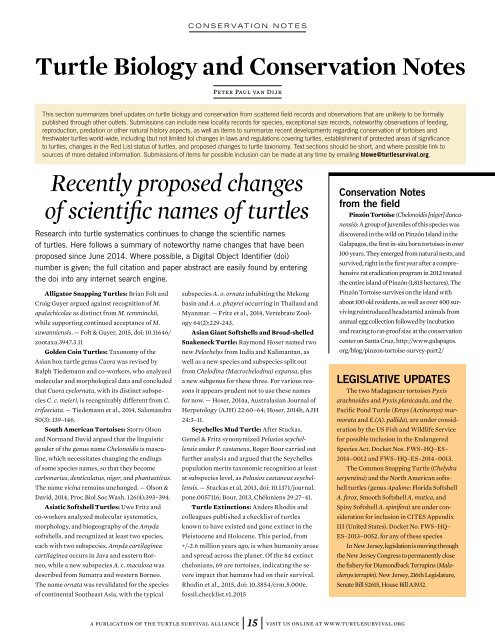Turtle Survival
2tUaeTbNi
2tUaeTbNi
You also want an ePaper? Increase the reach of your titles
YUMPU automatically turns print PDFs into web optimized ePapers that Google loves.
CONSERVATION NOTES<br />
<strong>Turtle</strong> Biology and Conservation Notes<br />
Peter Paul van Dijk<br />
This section summarizes brief updates on turtle biology and conservation from scattered field records and observations that are unlikely to be formally<br />
published through other outlets. Submissions can include new locality records for species, exceptional size records, noteworthy observations of feeding,<br />
reproduction, predation or other natural history aspects, as well as items to summarize recent developments regarding conservation of tortoises and<br />
freshwater turtles world-wide, including (but not limited to) changes in laws and regulations covering turtles, establishment of protected areas of significance<br />
to turtles, changes in the Red List status of turtles, and proposed changes to turtle taxonomy. Text sections should be short, and where possible link to<br />
sources of more detailed information. Submissions of items for possible inclusion can be made at any time by emailing hlowe@turtlesurvival.org.<br />
Recently proposed changes<br />
of scientific names of turtles<br />
Research into turtle systematics continues to change the scientific names<br />
of turtles. Here follows a summary of noteworthy name changes that have been<br />
proposed since June 2014. Where possible, a Digital Object Identifier (doi)<br />
number is given; the full citation and paper abstract are easily found by entering<br />
the doi into any internet search engine.<br />
Alligator Snapping <strong>Turtle</strong>s: Brian Folt and<br />
Craig Guyer argued against recognition of M.<br />
apalachicolae as distinct from M. temminckii,<br />
while supporting continued acceptance of M.<br />
suwanniensis. — Folt & Guyer, 2015, doi: 10.11646/<br />
zootaxa.3947.3.11<br />
Golden Coin <strong>Turtle</strong>s: Taxonomy of the<br />
Asian box turtle genus Cuora was revised by<br />
Ralph Tiedemann and co-workers, who analyzed<br />
molecular and morphological data and concluded<br />
that Cuora cyclornata, with its distinct subspecies<br />
C. c. meieri, is recognizably different from C.<br />
trifasciata. — Tiedemann et al., 2014, Salamandra<br />
50(3): 139–146.<br />
South American Tortoises: Storrs Olson<br />
and Normand David argued that the linguistic<br />
gender of the genus name Chelonoidis is masculine,<br />
which necessitates changing the endings<br />
of some species names, so that they become<br />
carbonarius, denticulatus, niger, and phantasticus.<br />
The name vicina remains unchanged. — Olson &<br />
David, 2014, Proc.Biol.Soc.Wash. 126(4):393–394.<br />
Asiatic Softshell <strong>Turtle</strong>s: Uwe Fritz and<br />
co-workers analyzed molecular systematics,<br />
morphology, and biogeography of the Amyda<br />
softshells, and recognized at least two species,<br />
each with two subspecies. Amyda cartilaginea<br />
cartilaginea occurs in Java and eastern Borneo,<br />
while a new subspecies A. c. maculosa was<br />
described from Sumatra and western Borneo.<br />
The name ornata was revalidated for the species<br />
of continental Southeast Asia, with the typical<br />
subspecies A. o. ornata inhabiting the Mekong<br />
basin and A. o. phayrei occurring in Thailand and<br />
Myanmar. — Fritz et al., 2014, Vertebrate Zoology<br />
64(2):229-243.<br />
Asian Giant Softshells and Broad-shelled<br />
Snakeneck <strong>Turtle</strong>: Raymond Hoser named two<br />
new Pelochelys from India and Kalimantan, as<br />
well as a new species and subspecies split out<br />
from Chelodina (Macrochelodina) expansa, plus<br />
a new subgenus for these three. For various reasons<br />
it appears prudent not to use these names<br />
for now. — Hoser, 2014a, Australasian Journal of<br />
Herpetology (AJH) 22:60–64; Hoser, 2014b, AJH<br />
24:3–11.<br />
Seychelles Mud <strong>Turtle</strong>: After Stuckas,<br />
Gemel & Fritz synonymized Pelusios seychellensis<br />
under P. castaneus, Roger Bour carried out<br />
further analysis and argued that the Seychelles<br />
population merits taxonomic recognition at least<br />
at subspecies level, as Pelusios castaneus seychellensis.<br />
— Stuckas et al, 2013, doi: 10.1371/journal.<br />
pone.0057116; Bour, 2013, Chéloniens 29:27–41.<br />
<strong>Turtle</strong> Extinctions: Anders Rhodin and<br />
colleagues published a checklist of turtles<br />
known to have existed and gone extinct in the<br />
Pleistocene and Holocene. This period, from<br />
+/-2.6 million years ago, is when humanity arose<br />
and spread across the planet. Of the 84 extinct<br />
chelonians, 69 are tortoises, indicating the severe<br />
impact that humans had on their survival.<br />
Rhodin et al., 2015, doi: 10.3854/crm.5.000e.<br />
fossil.checklist.v1.2015<br />
Conservation Notes<br />
from the field<br />
Pinzón Tortoise (Chelonoidis [niger] duncanensis):<br />
A group of juveniles of this species was<br />
discovered in the wild on Pinzón Island in the<br />
Galapagos, the first in-situ born tortoises in over<br />
100 years. They emerged from natural nests, and<br />
survived, right in the first year after a comprehensive<br />
rat eradication program in 2012 treated<br />
the entire island of Pinzón (1,815 hectares). The<br />
Pinzón Tortoise survives on the island with<br />
about 100 old residents, as well as over 400 surviving<br />
reintroduced headstarted animals from<br />
annual egg collection followed by incubation<br />
and rearing to rat-proof size at the conservation<br />
center on Santa Cruz. http://www.galapagos.<br />
org/blog/pinzon-tortoise-survey-part2/<br />
LEGISLATIVE UPDATES<br />
The two Madagascar tortoises Pyxis<br />
arachnoides and Pyxis planicauda, and the<br />
Pacific Pond <strong>Turtle</strong> (Emys (Actinemys) marmorata<br />
and E.(A). pallida), are under consideration<br />
by the US Fish and Wildlife Service<br />
for possible inclusion in the Endangered<br />
Species Act. Docket Nos. FWS–HQ–ES–<br />
2014–0012 and FWS–HQ–ES–2014–0013.<br />
The Common Snapping <strong>Turtle</strong> (Chelydra<br />
serpentina) and the North American softshell<br />
turtles (genus Apalone: Florida Softshell<br />
A. ferox, Smooth Softshell A. mutica, and<br />
Spiny Softshell A. spinifera) are under consideration<br />
for inclusion in CITES Appendix<br />
III (United States). Docket No. FWS–HQ–<br />
ES–2013–0052. for any of these species<br />
In New Jersey, legislation is moving through<br />
the New Jersey Congress to permanently close<br />
the fishery for Diamondback Terrapins (Malaclemys<br />
terrapin). New Jersey, 216th Legislature,<br />
Senate Bill S2615, House Bill A3932.<br />
a publication of the turtle survival alliance 15 visit us online at www.turtlesurvival.org


